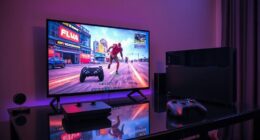HDR enhances your picture by improving contrast, brightness, and color range beyond standard displays. HDR10 uses static metadata, while HDR10+ and Dolby Vision add dynamic, scene-by-scene adjustments that optimize picture quality. Tone mapping ensures high dynamic range content fits your display’s capabilities without losing details, creating vibrant visuals. To get the most from your HDR experience, understanding these formats and how they work can make a big difference—so keep exploring to learn more.
Key Takeaways
- HDR10 uses static metadata and 10-bit color, while HDR10+ and Dolby Vision add dynamic metadata for scene-specific adjustments.
- Tone mapping translates high-brightness and wide color info into display limits, ensuring detailed and natural HDR visuals.
- Dynamic metadata in HDR10+ and Dolby Vision enhances scene-by-scene or frame-by-frame optimization for better image quality.
- Compatibility varies; HDR10 is most widely supported, while HDR10+ and Dolby Vision offer advanced features with limited device support.
- Proper calibration and device support are essential for maximizing HDR benefits and achieving vibrant, immersive images.
Understanding HDR Formats and Their Technical Foundations

To understand HDR formats and their technical foundations, recognizing how they improve picture quality by enhancing contrast, brightness, and color range beyond standard dynamic range (SDR) displays is essential. HDR achieves this by expanding the luminance levels, allowing highlights to shine brighter and shadows to be deeper, creating more realistic images. Unlike resolution, HDR focuses on how well a display reproduces brightness and color details, preserving fine nuances in both bright and dark areas. HDR10, the basic standard, uses static metadata and 10-bit color depth, while HDR10+ and Dolby Vision introduce dynamic metadata to optimize each scene or frame. Dolby Vision goes further with support for higher bit depths and more sophisticated tone mapping algorithms, delivering richer, more accurate visuals. Additionally, Kia Tuning techniques can enhance the viewing experience by optimizing display settings for better HDR performance, ensuring vividness and clarity in multimedia content.
The Role of Dynamic Metadata and How Tone Mapping Enhances HDR Content

Dynamic metadata plays a key role in maximizing HDR content’s visual impact by allowing adjustments on a scene-by-scene or frame-by-frame basis. This flexibility guarantees each part of a video is optimized for your display’s capabilities, enhancing brightness, contrast, and detail where needed. Proper calibration ensures the tone mapping process works effectively across different devices, maintaining consistent quality. Tone mapping translates HDR’s high-brightness and wide color information into what your screen can handle, preventing clipping or loss of detail in highlights and shadows. Effective tone mapping makes HDR content look more natural and vibrant, especially on mid-range or budget displays with limited peak brightness. Display calibration further enhances the accuracy of this process, ensuring the intended visual effects are preserved. Additionally, modern projectors with high contrast ratios can better reproduce the intended depth and richness of HDR content, further enhancing your viewing experience. Incorporating HDR standards like Dolby Vision and HDR10+ ensures dynamic metadata is utilized effectively for a more immersive experience, adapting to various display capabilities. Understanding display capabilities helps optimize HDR settings for the best possible quality across different devices.
Compatibility, Content Availability, and Real-World Visual Differences

Compatibility across HDR formats varies depending on your device, but generally, HDR10 remains the most widely supported standard, ensuring that most HDR content is viewable even on older or less advanced displays. HDR10’s broad support means you’ll find it on most TVs, streaming devices, and Blu-ray players. HDR10+ and Dolby Vision add dynamic metadata for improved picture quality, but not all devices or content support them. Many streaming services and disc manufacturers offer content in multiple formats, often with fallback options to HDR10. In real-world viewing, high-end TVs with advanced processing can maximize differences, such as more vibrant colors and better contrast with Dolby Vision. Budget models may show subtler improvements, making the format choice less noticeable. Overall, content availability and compatibility depend heavily on your hardware’s support. Furthermore, the presence of native HDR support in devices can significantly influence the overall viewing experience, as hardware capabilities play a crucial role in how well HDR formats are rendered. Additionally, ongoing developments in HDR technology continue to enhance image quality and compatibility across various devices. Staying informed about format support updates can help you optimize your viewing setup and enjoy the best possible HDR experience. Moreover, content management strategies by streaming platforms and manufacturers are evolving to improve HDR delivery and user experience.
Future Trends in HDR Technology and What They Mean for Viewers

Future HDR technology is set to deliver even more impressive visual experiences as display manufacturers push peak brightness levels higher and expand color gamuts. You can expect brighter images, richer colors, and more detailed highlights and shadows. Here’s what’s coming:
Future HDR will deliver brighter, more colorful, and more detailed visuals with advanced technology and broader compatibility.
- Increased Peak Brightness: Some TVs will reach up to 10,000 nits, making HDR effects pop like never before. This will significantly enhance the visual impact and realism of HDR content. As display technology advances, peak brightness levels are expected to continue rising, further improving image quality. Additionally, ongoing innovations in resources and tools for display manufacturing will support these higher performance standards. These improvements will also rely on advanced display materials that can sustain higher brightness without compromising longevity.
- Enhanced Color Gamut: Wider color spaces will produce more vibrant, lifelike images, closer to real-world scenes.
- Advanced Metadata: Dynamic metadata and smarter tone mapping will optimize content scene-by-scene, ensuring consistent quality across devices.
- Broader Compatibility: Future standards will harmonize multiple HDR formats, simplifying choices and improving playback for all viewers.
- Additionally, these advancements will benefit from ongoing innovations in battery technologies, ensuring that future portable display devices can support these high-performance features more efficiently.
These advances will make HDR richer, more immersive, and more accessible, elevating your viewing experience remarkably.
Frequently Asked Questions
Can Older TVS Display HDR Content Without Native HDR Support?
Yes, older TVs can display HDR content even without native HDR support, but the quality won’t be ideal. They often rely on external devices or processing to simulate HDR effects, which can result in less vibrant colors and lower contrast. You might notice details in highlights and shadows aren’t as clear. To get the best experience, upgrading to a TV with native HDR support or using a dedicated HDR-compatible device is recommended.
How Does HDR Impact Gaming Performance and Response Times?
Think of HDR as a vibrant paintbrush, adding depth and richness to your gaming canvas. It enhances visuals by delivering brighter highlights, darker shadows, and more vivid colors. This can elevate your gaming experience but may introduce slight delays due to the processing needed for tone mapping and dynamic adjustments. While it generally improves immersion, high response times might cause minor input lag, so balance your settings for ideal performance.
Are There Noticeable Differences in HDR Quality Between Streaming and Disc Content?
You’ll probably notice better HDR quality on disc content because it often has higher bitrates, richer color, and more dynamic range. Streaming might compress HDR data, leading to slight loss of detail or less vibrant colors, especially if your internet connection isn’t first-rate. However, with good streaming sources and a capable display, the difference can be subtle. For the best HDR experience, physical discs usually offer superior quality.
Does HDR Format Choice Influence Viewing Experience in Dark Room Settings?
Did you know that 70% of viewers prefer watching HDR content in dark rooms for better contrast? Choosing an HDR format definitely impacts your experience in low-light settings. Dolby Vision’s advanced tone mapping provides richer details and more vibrant highlights, making scenes pop with depth. HDR10+ offers dynamic adjustments scene-by-scene, but Dolby Vision’s superior processing truly enhances dark room viewing by preserving shadow details and reducing crushes for a more immersive experience.
Will Future HDR Standards Eliminate the Need to Choose Between Formats?
Future HDR standards are likely to reduce the importance of choosing between formats, as advances in display technology and processing will enable compatibility with multiple HDR types seamlessly. You won’t need to worry about selecting a specific format because newer TVs and processors will adapt content dynamically, optimizing brightness, contrast, and color regardless of the original HDR format. This evolution aims to provide a more consistent, high-quality viewing experience across all devices.
Conclusion
By understanding HDR formats like HDR10, HDR10+, and Dolby Vision, you discover a world where colors burst like a vibrant painter’s palette. Tone mapping acts as your personal guide, ensuring every detail shines through, no matter your device. As technology evolves, it’s like opening a window to a brighter, more immersive future—where your viewing experience becomes a vivid landscape bursting with life, waiting to be explored with every scene.









